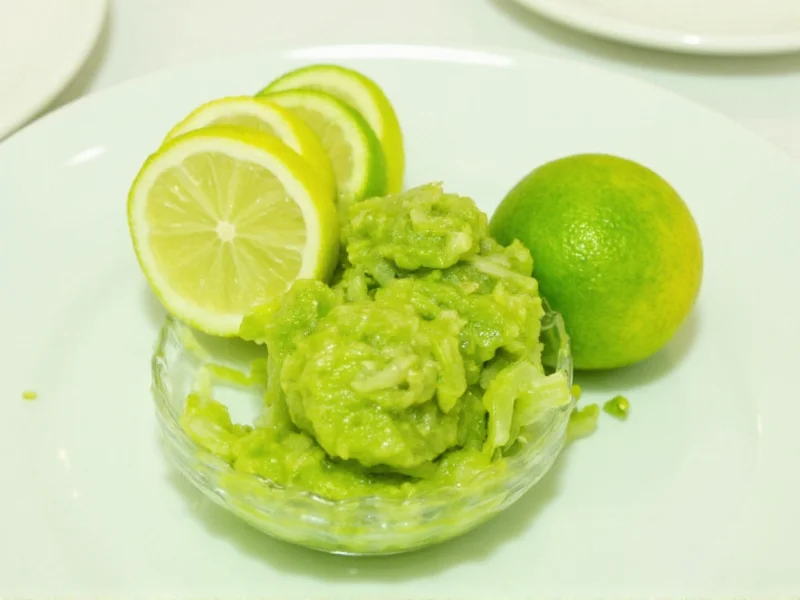When you're in the middle of preparing your favorite Mexican dish or cocktail and realize you've run out of limes, knowing reliable lime substitutes becomes essential. Whether you're making guacamole, ceviche, or margaritas, the right substitute maintains the dish's integrity while providing that crucial citrus element. This guide explores practical alternatives backed by culinary science, helping you choose the best option for your specific recipe needs.
Understanding Lime's Role in Cooking
Lime contributes more than just sourness to dishes—it provides brightness, balances flavors, and can even affect texture through its acidity. The citric acid in lime juice (typically 4-6%) reacts with other ingredients, which is why finding an appropriate substitute requires understanding both flavor profile and acid content. When searching for what can I use instead of lime in margarita, you need something with similar acidity to properly balance the tequila and triple sec.
Top Lime Substitutes Ranked by Effectiveness
Not all substitutes work equally well across all applications. The best choice depends on your specific recipe and what aspect of lime you're trying to replicate—flavor, acidity, or both.
| Substitute | Best For | Substitution Ratio | Flavor Notes |
|---|---|---|---|
| Lemon juice | Most savory dishes, baked goods | 1:1 replacement | Slightly sweeter, less floral than lime |
| Vinegar + water | Canning, pickling, marinades | 1 part vinegar : 2 parts water | Sharp acidity without citrus notes |
| Orange + lemon juice | Cocktails, desserts | 2 parts orange : 1 part lemon | Balanced citrus profile |
| Citric acid | Canning, preserving | 1/8 tsp per tbsp lime juice | Pure acidity, no flavor |
| White wine vinegar | Ceviche, seafood dishes | 1 part vinegar : 3 parts water | Milder acidity with subtle fruit notes |
Detailed Substitute Analysis
Lemon Juice: The Most Accessible Alternative
Lemon juice serves as the most straightforward substitute for fresh lime juice in recipes. While lemons contain slightly less citric acid than limes (5-6% vs 4-6%), their flavor profile is closest among common citrus options. Use a 1:1 replacement ratio, but note that lemon's sweeter, less floral notes work better in savory applications than desserts. For best lime juice substitute for guacamole, lemon works acceptably though it lacks lime's distinctive floral notes that prevent browning as effectively.
Vinegar-Based Solutions for Acidity Needs
When you need acidity without strong citrus flavor, diluted vinegars provide excellent options. For canning or preserving where lime substitute for canning is needed, use a 1:2 ratio of white vinegar to water. This maintains proper pH levels without overpowering flavors. White wine vinegar offers a more subtle alternative that works surprisingly well as a substitute for lime in ceviche, as its mild fruitiness complements seafood better than plain vinegar.
Citrus Combinations for Balanced Flavor
For recipes where flavor matters as much as acidity, combining citrus juices creates superior results. A mixture of two parts orange juice to one part lemon juice mimics lime's sweet-tart balance effectively. This blend works particularly well in cocktails where you're searching for lime replacement in cocktails. The orange contributes sweetness while lemon provides the necessary acidity, creating a profile closer to lime than either juice alone.
Specialty Options for Specific Applications
Citric acid (sometimes labeled as sour salt) provides pure acidity without flavor, making it ideal for canning where pH control is critical but citrus flavor isn't desired. Use 1/8 teaspoon of citric acid per tablespoon of lime juice required. Key lime juice works as a direct substitute but has a more intense, floral flavor that may overpower some dishes. For those seeking a non-citrus lime substitute, consider verjus (unripe grape juice), which offers similar acidity with a more neutral flavor profile.
When Substitutes Fail: Critical Recipe Considerations
Not all recipes tolerate substitutions equally. In traditional ceviche, lime's specific acidity and flavor compounds are essential for properly 'cooking' the fish. Similarly, authentic guacamole relies on lime's unique properties to prevent oxidation while enhancing avocado's flavor. When substituting in these dishes, expect slight variations in both appearance and taste. For baking applications, remember that changing citrus types affects both flavor and chemical reactions—lime's higher acidity can impact rising agents differently than lemon.
Practical Tips for Successful Substitution
- Always taste as you go when substituting—adjust quantities based on your specific recipe
- For guacamole, add substitute gradually to prevent overwhelming the delicate avocado flavor
- In cocktails, reduce sweetener slightly when using lemon juice to compensate for its sweeter profile
- When making ceviche, increase marinating time by 15-20% with less acidic substitutes
- For baking, consider adding 1/8 teaspoon baking soda per cup of citrus substitute to balance pH











 浙公网安备
33010002000092号
浙公网安备
33010002000092号 浙B2-20120091-4
浙B2-20120091-4